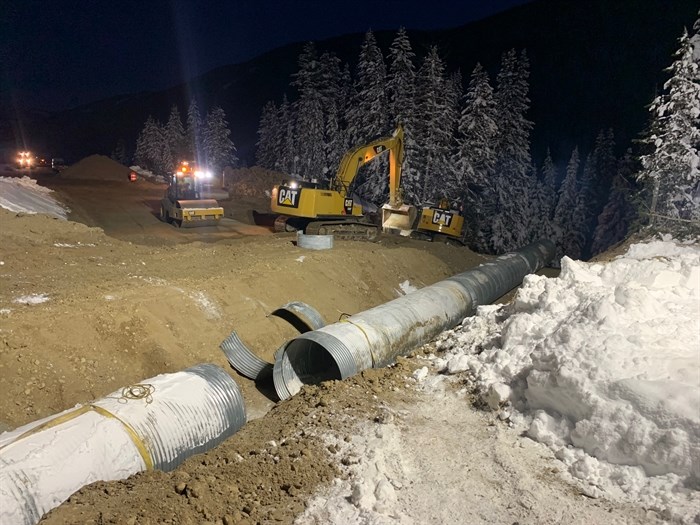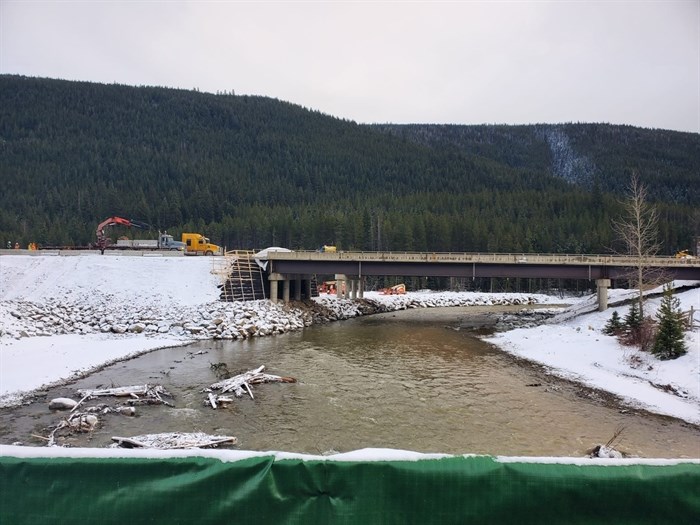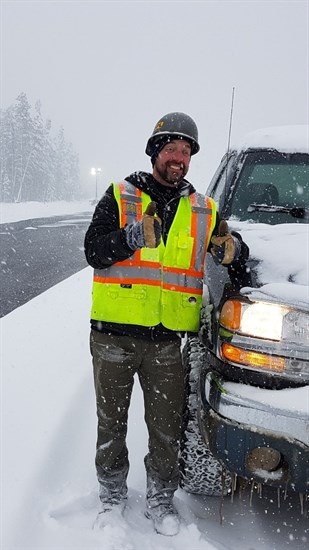
Crews worked around the clock to get the Coquihalla Highway open five weeks after it was washed out
Image Credit: Submitted/Yellowhead Road and Bridge
December 24, 2021 - 7:00 AM
The Coquihalla Highway likely would have been closed into January if it wasn’t for the quick action of highways maintenance crews and warm fall weather.
The quick action was led by Kamloops resident Dave Duncan who is the general manager for the Merritt division of Yellowhead Road and Bridge, or YRB, that maintains the Coquihalla Highway down to Portia, below the Snowshed Hill.
The highway was closed Sunday, Nov. 14, after a large mudslide crossed the roadway below Snowshed Hill, the first of what grew into 20 places where the highway was seriously damaged. That early closure meant travellers did not have to be rescued as they did on other highways. But more of the infrastructure would have been lost if crews hadn't moved quickly.
READ MORE: Coquihalla closed due to mudslide between Hope and Merritt
“I was on site on the Monday morning,” Duncan told iNFOnews.ca. “We didn’t really know what we had lost and what we hadn’t lost because you could only get so far up the highway because you ran into roadblocks.
“I was down at the Brodie Bridge with a small crew and some local subcontractors. We had a bridge that was in the process of being undermined, so we were trying to put rock under the abutment and try to protect it. Once we got that protected we went to the next site and looked at the damage.”
In all, there were 20 blockages and washouts on the highway. It’s the main truck route from the Lower Mainland to the rest of B.C. and Canada. All highways between the two areas were closed for two weeks before Highway 3 and 99 were opened to essential traffic.
But, in those first hours, the battle was to save what infrastructure could be saved.
“The river moved its channel all over the place,” Duncan said. “There were five-foot boulders and trees two feet wide coming down the river, getting caught up in bridge abutments and they were washing away side slopes.
“That happened at the Brodie Bridge that we were trying to save. The river was pointed directly at the abutment of the bridge, where the bridge attaches to the side of the road. It was basically washing out the abutment. We were watching the gravel under the bridge wash away and the concrete pad the bridge sits on become more and more undermined and exposed. We were probably within a couple of hours of losing that bridge as well.”
They were hauling rock from Merritt by 11 a.m. that day and using excavators from local contractors and some working on the Trans Mountain Pipeline.
“The safety of the workers was our most paramount thing,” Duncan said. “So, you look at the river. You watch where it’s going. Nobody gets close to the water. It was just too turbulent and too dangerous at that point. You’ve got large excavators with long reach buckets, sitting well back from the river, placing and dropping boulders where they can safely do that into the river. Basically, all you’re trying to do at that point is redirect the flow of the water away from the bridge and redirect it to the other side where the erosion won’t do as much damage.”
Once the Brodie Bridge was saved, they moved on to other areas. The Bottletop Bridge, about 15 km north of the Coquihalla Summit, was totally washed out.

Rebuilding the Bottletop Bridge.
Image Credit: Submitted/Yellowhead Road and Bridge
On Murray Flats, below Larson Hill, there were three sections where either the northbound or southbound lanes were totally washed out. In one section they could only save one lane from the rushing Coldwater River.
Once they saved as much as they could, Duncan and local contractors started the massive job of rebuilding what had been lost.
Initially, the province said the highway wasn’t expected to reopen until late January. Commercial trucks started hauling loads on it, Monday, Dec. 20.
READ MORE: iN VIDEO: Coquihalla Highway reopens to essential commercial traffic today
“The real credit should go to the workers who put in their blood sweat and tears to make this happen,” Duncan said in an email, referring to “the subcontractors who worked so hard on the response efforts, and the Ministry of Transportation staff who worked with us to make this happen so quickly.”While each section brought its own unique challenge, the most difficult was probably the Bottletop Bridge site, Duncan said.
Mechanically stabilized earth walls were built and precast concrete bridge slabs were poured by local suppliers then lifted into place with a crane.
“They basically jumped from the wall that was built to the remaining bridge section that was standing,” Duncan said.
Crews worked around the clock seven days a week and were aided by some great engineers who came up with creative ways to not only do the work, but do it quickly, Duncan said.

It was snowing and -20 Celsius as the pavement was being laid down.
Image Credit: Submitted/Yellowhead Road and Bridge
“That’s the tricky part,” he said. “You’ve got the concept then you have to safely engineer it while, at the same time, advancing construction, which is tricky to do. Everyone jumped in and did it together and it was ultimately a successful outcome.”
As they got rolling, they realized they could get the repairs done sooner than forecast.
“As you start to build some of the infrastructure and do repairs, you start to get a better idea of what’s possible,” Duncan said. “We started to see we were making better progress than we thought we would.”
The other big factor was the weather.
After the initial downpour that caused all the damage there were two more rainstorms but, after that, the weather was drier and there wasn’t heavy snow to deal with.
READ MORE: iN VIDEO: Drone footage showcases scale of work done to reopen Coquihalla
“We got a three-week window of pretty reasonable fall weather, early winter weather,” Duncan said. “In the last 10 days we had two metres of snowfall. We were really challenged to put the finishing touches on it to get it open because of that snowfall. If we had been hampered by the kind of snow we were hampered with in the last 10 days we would have been into January before we got this done..”
As it was, pavement had to be laid down at -20 Celsius so it’s rougher than regular pavement.

Will McKechnie supervised paving operations.
Image Credit: Submitted/Yellowhead Road and Bridge
Duncan estimates that only about 15 to 20 km of the 130 km stretch between Merritt and Hope were damaged.
There’s still a couple of spots where only two lanes are open and some areas where trucks have to cross from the southbound to northbound lanes because only two lanes are open. Trucks have to slow down to 50 km/h in those sections but can cruise at 100 km/h for the rest of the trip.
READ MORE: Why you need to worry more than ever about those highway rigs on B.C. highways
Duncan estimated the trip is only taking five or so minutes longer.
Members of his crews who aren’t needed to plow snow and do regular maintenance, are getting a bit of time off but will be back in January to do more work shoring up the road so it can endure the spring freshet.
“Many staff live in Merritt and were evacuated,” Duncan said. The whole of Merritt was evacuated the same day the highway washed out after the Coldwater River spilled its banks and cut a new channel though the city.
READ MORE: BREAKING: Entire city of Merritt under evacuation order
“Some had significant damage to their homes and property,” Duncan said. “The vast majority of them continued to work throughout the disaster, coming back to ensure highway maintenance services continued uninterrupted. The same is true for the many Merritt-based contractors that assisted us in the early days of the flood response."
Other members of the Yellowhead Road and Bridge crews were working on repairs to Highway 1 and Highway 8 at the same time, and continue there.
Access has been restored to some First Nations communities along Highway 8 (between Merritt and Spences Bridge) but more needs to be done.
Duncan could not estimate how long it will take to reopen Highway 1 through the Fraser Canyon. There are three areas still needing repair and that work is complicated by the fact that rail lines run above or below the highway.
About two-thirds of the Coquihalla repairs were within Yellowhead Road and Bridge’s jurisdiction. The rest were in Emil Anderson Construction out of Hope's territory.
Duncan is confident the structures that were saved, repaired or replaced can handle the spring freshet. He expects it will take a couple of years before the highway and its bridges will be fully repaired or replaced.
To contact a reporter for this story, email Rob Munro or call 250-808-0143 or email the editor. You can also submit photos, videos or news tips to the newsroom and be entered to win a monthly prize draw.
We welcome your comments and opinions on our stories but play nice. We won't censor or delete comments unless they contain off-topic statements or links, unnecessary vulgarity, false facts, spam or obviously fake profiles. If you have any concerns about what you see in comments, email the editor in the link above.
News from © iNFOnews, 2021